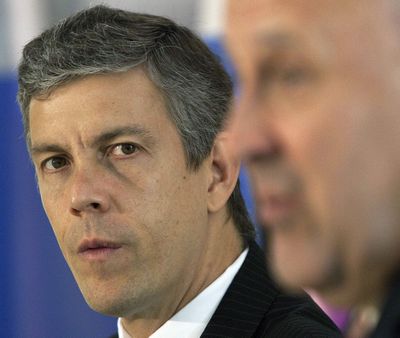Obama pushing school reform
Unprecedented grant program unveiled today

WASHINGTON – President Barack Obama is leaning hard on the nation’s schools, using the promise of $4 billion in federal aid – and the threat of withholding it – to strong-arm the education establishment to accept more charter schools and performance pay for teachers.
The pressure campaign has been under way for months as Education Secretary Arne Duncan travels the country delivering a blunt message to state officials who have resisted change for decades: Embrace reform or risk being shut out.
“What we’re saying here is, if you can’t decide to change these practices, we’re not going to use precious dollars that we want to see creating better results; we’re not going to send those dollars there,” Obama said in an Oval Office interview Wednesday. “And we’re counting on the fact that, ultimately, this is an incentive, this is a challenge for people who do want to change.”
Today, Obama will officially announce the “Race to the Top,” a competition for $4.35 billion in grants. He wants states to use funds to ease limits on charter schools, tie teacher pay to student achievement and move for the first time toward common academic standards.
It is part of a broader effort to improve school achievement with a $100 billion increase in education funding, more money for community colleges and an increase in Pell Grants for college students.
Duncan has used the Race to the Top fund, created through the economic stimulus law, as leverage to drive the president’s education agenda in Rhode Island, Tennessee, Colorado and elsewhere.
Never has an education secretary been given so much money by Congress with such open-ended authority, according to current and former federal education officials. Margaret Spellings, Duncan’s predecessor under George W. Bush, had a tiny fraction of that amount at her disposal.
Obama said stagnating student achievement is part of a “slow-rolling crisis” and represents a threat to the country’s economic future. Stark achievement gaps remain for minority and low-income students. In some big cities, fewer than half of high school students graduate on time. The United States trails international competitors in math and science.
In trying to reverse those trends, he faces the same decentralized educational system and resistance to change that hampered Bush’s No Child Left Behind law, which required annual testing to hold schools accountable for closing achievement gaps. Like his predecessor, Obama is using the federal treasury to power through the obstacles.
Unlike Bush, Obama must try to carefully bring along the teachers unions, a key Democratic constituency that so far has praised the president’s goals but remains wary of the threat to members’ paychecks and the promise of tenure.
“There are going to be elements within the teachers union where they’re just resistant to change, because people inherently are resistant to change,” Obama said during the 20-minute interview. “Teachers aren’t any different from any politicians or corporate CEOs. There are going to be certain habits that have been built up that they don’t want to change.”
Already, some legislatures, eager for a share of the massive federal money pot, have begun clearing the way for more charter schools and taking other steps to show they are pro-reform.
The effort has helped Obama enlarge the federal role in an arena dominated by state and local governments, but there is deep skepticism about his approach.
Congressional Republicans say the initiative, coupled with another $650 million for school reform under Duncan’s control, is wasteful.
“We just took a big old checkbook with a $5 billion total behind it and handed it to the secretary and said, ‘Write a whole bunch of checks,’ ” said Rep. John Kline of Minnesota, the top Republican on the House Education and Labor Committee. “I’m uncomfortable that we’re doing that.”
Obama says the money will be distributed to states that can demonstrate results backed by data that show student scores and teacher performance are improving.
“It’s not based on politics, it’s not based on who’s got more clout, it’s not based on what certain constituency groups are looking for, but it’s based on what works,” he said. “Now, what we’re also doing, though, is we’re saying this is voluntary. If there are states that just don’t want to go in this direction, that’s their prerogative.”
Leaders of the two largest teachers unions praise Obama’s intentions to lift standards, raise teacher quality and turn around low-performing schools. But they acknowledge concerns about specifics.
“We’re absolutely in sync with where they’re going,” said Dennis Van Roekel, president of the National Education Association. Van Roekel said performance pay, charter schools and links between student and teacher data raise difficult issues for his union.
On the data issue, Van Roekel said he told Duncan: “This is going to be a tough one for us.”
“The devil really is in the details,” American Federation of Teachers President Randi Weingarten said. Many teachers fear they will be fired if they are judged unfairly on student test scores, Weingarten said. “You want to be respectful of an administration that believes in public education. And on the issues where you have differences, you try to work those out.”
For Duncan, the stimulus law has provided an opportunity to steer billions of dollars to school reform on his own terms. Duncan has broad control over the Race to the Top fund and the $650 million to spur innovation through local school systems and nonprofit groups.
Today, the department will formally unveil its criteria for the competition. Applications will be accepted starting late this year for states that want to be first in line, or next spring, for those needing more time.
Money will be awarded in two waves next year. Up to $350 million from the fund will be carved out to support a recently announced effort by 46 states to develop common academic standards.